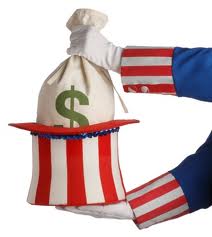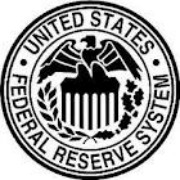QE is not “printing money” as it does not increase the amount of money in circulation. Handing out $100 bills would be printing money. By purchasing Treasuries and MBS, the Fed raises the price of those securities and thus lowers interest rates. And lower rates can certainly result in an increased desire to borrow. But that increased demand will only lead to money supply growth if private banks make loans.
Tag Archives: Quantitative Easing
Fed Funds
While the Fed’s balance sheet has mushroomed from $850 billion in 2008 to $3.3 trillion today as a result of three rounds of quantitative easing, the last of which is not yet done, these holdings bring in considerable amounts of interest. Because the Fed must return all residual earnings to the Treasury, in 2012 the Fed paid Uncle Sam $89 billion! In 2011, it was $77 billion. Long Live QE!
Currency Clash
When the Fed announces a third round of quantitative easing, expect unintended cross-currency consequences. Last time, the dollar fell against a host of currencies, but now central banks in many of those same countries will actively intervene to prevent their currencies from appreciating against the greenback. However, other countries seem unprepared to intervene such as Australia, New Zealand and South Korea. As a result, bet on their currencies rising.
Quantitative Uneasy
While Bernanke undoubtedly wanted to do more in the way of monetary stimulus than he did, yesterday’s Fed’s decision to explicitly commit to keeping rates low through late ’14, was the best he could do in place of another round of quantitative easing. Recall that bond purchases (QE1 and QE2) have become increasingly unpopular with some investors and many Republicans who consistently (and mistakenly) believe that they will eventually lead to higher inflation.
The Fed, Not Out of Ammo!
 The Federal Reserve still has options, short of QE3, if it wants to encourage more lending. First, it can reduce to zero the rate of interest it pays banks on deposits held at the Fed. Second, it could sell short term Treasuries it holds and with the proceeds buy long term Treasuries. This would reduce long term rates without harming short term rates, as the Fed has pledged to keep the fed funds rate at near zero till mid ’13.
The Federal Reserve still has options, short of QE3, if it wants to encourage more lending. First, it can reduce to zero the rate of interest it pays banks on deposits held at the Fed. Second, it could sell short term Treasuries it holds and with the proceeds buy long term Treasuries. This would reduce long term rates without harming short term rates, as the Fed has pledged to keep the fed funds rate at near zero till mid ’13.
Quantitative Easing 3?
 QE worked miracles by injecting massive liquidity into the economy in ’08 and ’09, and staved off a depression. While smaller, QE2 boosted equity prices and weakened the $US which boosted exports, raised commodity prices and headline inflation. If we get QE3, which is likely to be less successful than QE2, it’s because inflation’s receding, the stock market’s falling and Congress is MIA
QE worked miracles by injecting massive liquidity into the economy in ’08 and ’09, and staved off a depression. While smaller, QE2 boosted equity prices and weakened the $US which boosted exports, raised commodity prices and headline inflation. If we get QE3, which is likely to be less successful than QE2, it’s because inflation’s receding, the stock market’s falling and Congress is MIA
LIBOR Losing Relevance
 The London Interbank Offered Rate (LIBOR) is losing relevance. Outstanding LIBOR borrowings have fallen 63% in the past 3 years and it has failed to capture turmoil in the banking sector due to the Euro crisis. Why? Central banks around the world have given banks cheap access to cash, banks have increased customer deposits and banks have huge cash deposits at the Fed due to Quantitative Easing.
The London Interbank Offered Rate (LIBOR) is losing relevance. Outstanding LIBOR borrowings have fallen 63% in the past 3 years and it has failed to capture turmoil in the banking sector due to the Euro crisis. Why? Central banks around the world have given banks cheap access to cash, banks have increased customer deposits and banks have huge cash deposits at the Fed due to Quantitative Easing.
Aggressive Fed, Tough Sell
We know the Bernanke lead Fed is willing to be extremely aggressive. But as we saw in 2010 the hurdle is high for more Quantitative Easing. We need evidence of A) a double-dip B) a stock market correction of at least 15 or 20% and C) the real prospect of deflation. But if headline inflation is running at 4% and other central banks are tightening QE3 will be a very tough sell.



